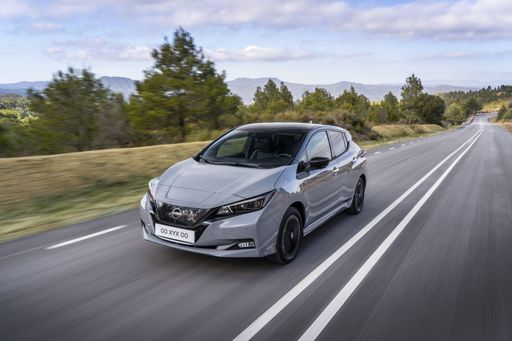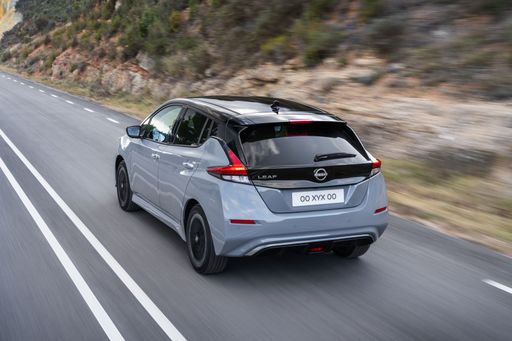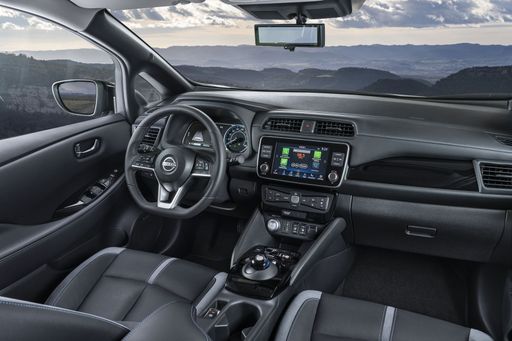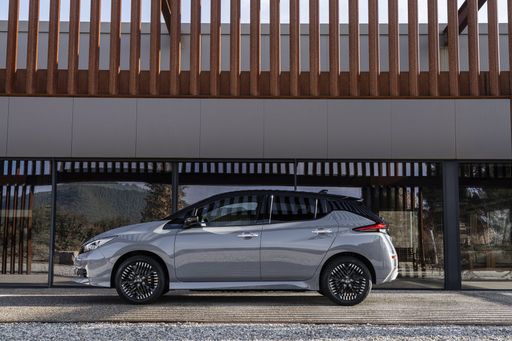Nissan Leaf VS Rolls-Royce Phantom – Specs, Efficiency & Price Comparison
Which model is the better choice – the Nissan Leaf or the Rolls-Royce Phantom? We compare performance (217 HP vs 571 HP), boot capacity (394 L vs 548 L), efficiency (16.70 kWh vs 15 L), and of course, the price (30800 £ vs 372900 £).
Find out now which car fits your needs better!
The Nissan Leaf (Hatchback) is powered by a Electric engine and comes with a Automatic transmission. In comparison, the Rolls-Royce Phantom (Sedan) features a Petrol engine and a Automatic gearbox.
When it comes to boot capacity, the Nissan Leaf offers 394 L, while the Rolls-Royce Phantom provides 548 L – depending on what matters most to you. If you’re looking for more power, you’ll need to decide whether the 217 HP of the Nissan Leaf or the 571 HP of the Rolls-Royce Phantom suits your needs better.
There are also differences in efficiency: 16.70 kWh vs 15 L. In terms of price, the Nissan Leaf starts at 30800 £, while the Rolls-Royce Phantom is available from 372900 £.
Compare all the key specs now and find out which model fits your lifestyle best!
Nissan Leaf
The Nissan Leaf stands out as a pioneering model in the realm of electric vehicles, known for its impressive blend of practicality and eco-friendliness. It offers a smooth and quiet driving experience, making it an ideal choice for city commuting and longer journeys alike. The interior design is both comfortable and intuitive, providing drivers with a sense of modernity and ease of use.
details @ germany.nissannews.com
@ germany.nissannews.com
 @ germany.nissannews.com
@ germany.nissannews.com
 @ germany.nissannews.com
@ germany.nissannews.com
 @ germany.nissannews.com
@ germany.nissannews.com
Rolls-Royce Phantom
The Phantom stands as the epitome of luxury and craftsmanship, effortlessly merging opulence with unparalleled performance. With its iconic design and attention to detail, this flagship sedan commands respect on the road while cocooning its passengers in sumptuous comfort. Every journey in the Phantom is an experience, where timeless elegance meets cutting-edge technology.
details

|
|
|
|
|
Costs and Consumption |
|
|---|---|
|
Price
30800 - 37200 £
|
Price
372900 - 447400 £
|
|
Consumption L/100km
-
|
Consumption L/100km
15 - 15.2 L
|
|
Consumption kWh/100km
16.7 - 17.8 kWh
|
Consumption kWh/100km
-
|
|
Electric Range
270 - 385 km
|
Electric Range
-
|
|
Battery Capacity
39 - 59 kWh
|
Battery Capacity
-
|
|
co2
0 g/km
|
co2
341 - 344 g/km
|
|
Fuel tank capacity
-
|
Fuel tank capacity
100 L
|
Dimensions and Body |
|
|---|---|
|
Body Type
Hatchback
|
Body Type
Sedan
|
|
Seats
5
|
Seats
5
|
|
Doors
5
|
Doors
4
|
|
Curb weight
1580 - 1756 kg
|
Curb weight
2560 - 2610 kg
|
|
Trunk capacity
385 - 394 L
|
Trunk capacity
0 - 548 L
|
|
Length
4490 mm
|
Length
5762 - 5982 mm
|
|
Width
1788 mm
|
Width
2018 mm
|
|
Height
1540 - 1545 mm
|
Height
1646 - 1656 mm
|
|
Payload
384 - 415 kg
|
Payload
390 - 440 kg
|
Engine and Performance |
|
|---|---|
|
Engine Type
Electric
|
Engine Type
Petrol
|
|
Transmission
Automatic
|
Transmission
Automatic
|
|
Transmission Detail
Reduction Gearbox
|
Transmission Detail
Automatikgetriebe
|
|
Drive Type
Front-Wheel Drive
|
Drive Type
All-Wheel Drive
|
|
Power HP
150 - 217 HP
|
Power HP
571 HP
|
|
Acceleration 0-100km/h
6.9 - 7.9 s
|
Acceleration 0-100km/h
5.3 - 5.4 s
|
|
Max Speed
144 - 157 km/h
|
Max Speed
250 km/h
|
|
Torque
320 - 340 Nm
|
Torque
900 Nm
|
|
Number of Cylinders
-
|
Number of Cylinders
12
|
|
Power kW
110 - 160 kW
|
Power kW
420 kW
|
|
Engine capacity
-
|
Engine capacity
6749 cm3
|
General |
|
|---|---|
|
Model Year
2019
|
Model Year
2020
|
|
CO2 Efficiency Class
A
|
CO2 Efficiency Class
G
|
|
Brand
Nissan
|
Brand
Rolls-Royce
|
Nissan Leaf
Introduction to the Nissan Leaf: A Pioneer in Electric Mobility
The Nissan Leaf has established itself as a trailblazer in the realm of electric vehicles (EVs) since its launch. As we delve into its present-day iterations, the Leaf continues to soar in popularity due to remarkable advancements in technology and sustainability. Let's explore what makes the Nissan Leaf a standout in today's automotive market.
Power and Performance: Under the Hood of the Nissan Leaf
The Nissan Leaf boasts a power output ranging from 150 to 217 PS, depending on the battery option chosen. The vehicle's electric motor, a product of cutting-edge engineering, offers instant torque ranging from 320 to 340 Nm, resulting in impressive acceleration capabilities. The 0 to 100 km/h dash is achieved in as little as 6.9 seconds, showcasing its prowess in electric performance.
Battery Technology: Efficient Energy Management
When discussing the Nissan Leaf, battery technology is at the forefront. The available battery capacities range from 39 to 59 kWh, supporting an electric range between 270 to 385 km. This flexibility allows drivers to choose a model that best fits their driving habits, providing peace of mind for longer journeys without frequent recharging.
Sustainability: The Environmental Edge
One of the primary attractions of the Nissan Leaf is its commitment to sustainability. As an all-electric vehicle, it produces zero CO2 emissions, placing it in the top tier of the CO2-efficiency class with an 'A' rating. This clean energy approach contributes significantly to reducing environmental impact and supports Nissan's drive towards a greener future.
Design and Comfort: Aesthetic Appeal and Practicality
The Nissan Leaf is not just about efficiency; it's also designed for comfort and utility. With its sleek hatchback body and dimensions of 4490 mm in length, 1788 mm in width, and a height of up to 1545 mm, it offers ample interior space. The boot capacity ranges from 385 to 394 litres, providing sufficient storage for everyday needs. The model accommodates five passengers comfortably, ensuring a pleasant ride for everyone.
Innovations and Safety: Advanced Features for Peace of Mind
Nissan equips the Leaf with an array of intelligent features that enhance safety and convenience. The available equipment lines, including N-CONNECTA, Tekna, e+ N-CONNECTA, and e+ Tekna, offer varying levels of technology integration. ProPILOT Assist, e-Pedal, and a comprehensive suite of driver-assistance technology are just a few examples that highlight Nissan's commitment to innovation in the EV market.
Conclusion: The Nissan Leaf Continues to Lead
With prices ranging from €35,900 to €43,400, the Nissan Leaf remains an attractive choice for those looking to embrace electric mobility. It perfectly balances performance, design, and sustainability, making it a compelling choice in the competitive EV landscape. The Nissan Leaf not only represents the future of driving but also reinforces why it continues to be a leader in the electric vehicle community.
Rolls-Royce Phantom
Elegance Meets Innovation: The Rolls-Royce Phantom
The Rolls-Royce Phantom stands as a paragon of luxury and untamed sophistication in the automotive world. Renowned for its unrivaled comfort and performance, the Phantom is more than just a vehicle; it is an experience that redefines what luxury means in the modern age.
Technical Prowess
At the heart of the Phantom lies a powerful 6.8-liter V12 petrol engine that produces a staggering 571 horsepower and 900 Nm of torque. This powerhouse engine ensures that the Phantom not only offers opulent comfort but also remarkable performance. The Phantom accelerates from 0 to 100 km/h in just 5.3 seconds, showcasing its ability to combine luxury with exhilarating speed.
With an automatic transmission and all-wheel-drive capabilities, the Phantom delivers a smooth and responsive driving experience, allowing for effortless navigation through various terrains. For those seeking an even more elongated experience, the Phantom EWB (Extended Wheelbase) option extends the platform, offering additional rear-seat luxury without compromising dynamic performance.
Innovative Features
The Phantom is replete with cutting-edge technology designed not only for convenience but also for enhancing the driving experience. Among its standout features is a sophisticated infotainment system, seamlessly integrated into the luxurious interior, ensuring that every touch is as intuitive as it is elegant. Moreover, the inclusion of high-end sound systems elevates the overall ambiance, making every journey exceptional.
In addition to these features, the Phantom boasts an impressive trunk capacity of 548 liters, making it practical for both everyday use and luxury travel. Its fuel tank capacity of 100 liters complements its range, ensuring long-distance journeys are undertaken with ease.
Dimensions and Comfort
When it comes to dimensions, the Phantom does not shy away from its grandeur. Measuring 5,762 mm in length (or 5,982 mm for the EWB variant), 2,018 mm in width, and standing at a commanding height of between 1,646 mm and 1,656 mm, the Phantom is designed to make a statement. With a weight range of 2,560 kg to 2,610 kg, the construction exudes robustness while still providing an exhilarating drive.
The interior of the Phantom is a sanctuary, designed with the finest materials and craftsmanship. Seating five passengers comfortably, every detail, from the sumptuous leather upholstery to the handcrafted wood accents, reflects Rolls-Royce's dedication to providing a superior luxury experience.
Environmental Considerations
In a world increasingly focused on environmental impact, the Phantom's CO2 emissions are rated at 341 g/km for the standard model and 344 g/km for the EWB. While not the most eco-friendly option available, Rolls-Royce has taken steps to ensure that even within the luxury market, there is an awareness of sustainability.
Conclusion
The Rolls-Royce Phantom remains an unmistakable icon of luxury and performance. With its perfect blend of avant-garde technology, staggering power, and exquisite craftsmanship, it paves the way for what a luxury sedan should represent in the 21st century. Whether it's for a grand entrance or an escapade into the wilderness, the Phantom is engineered to deliver, time and again.
The prices and data displayed are estimates based on German list prices and may vary by country. This information is not legally binding.
